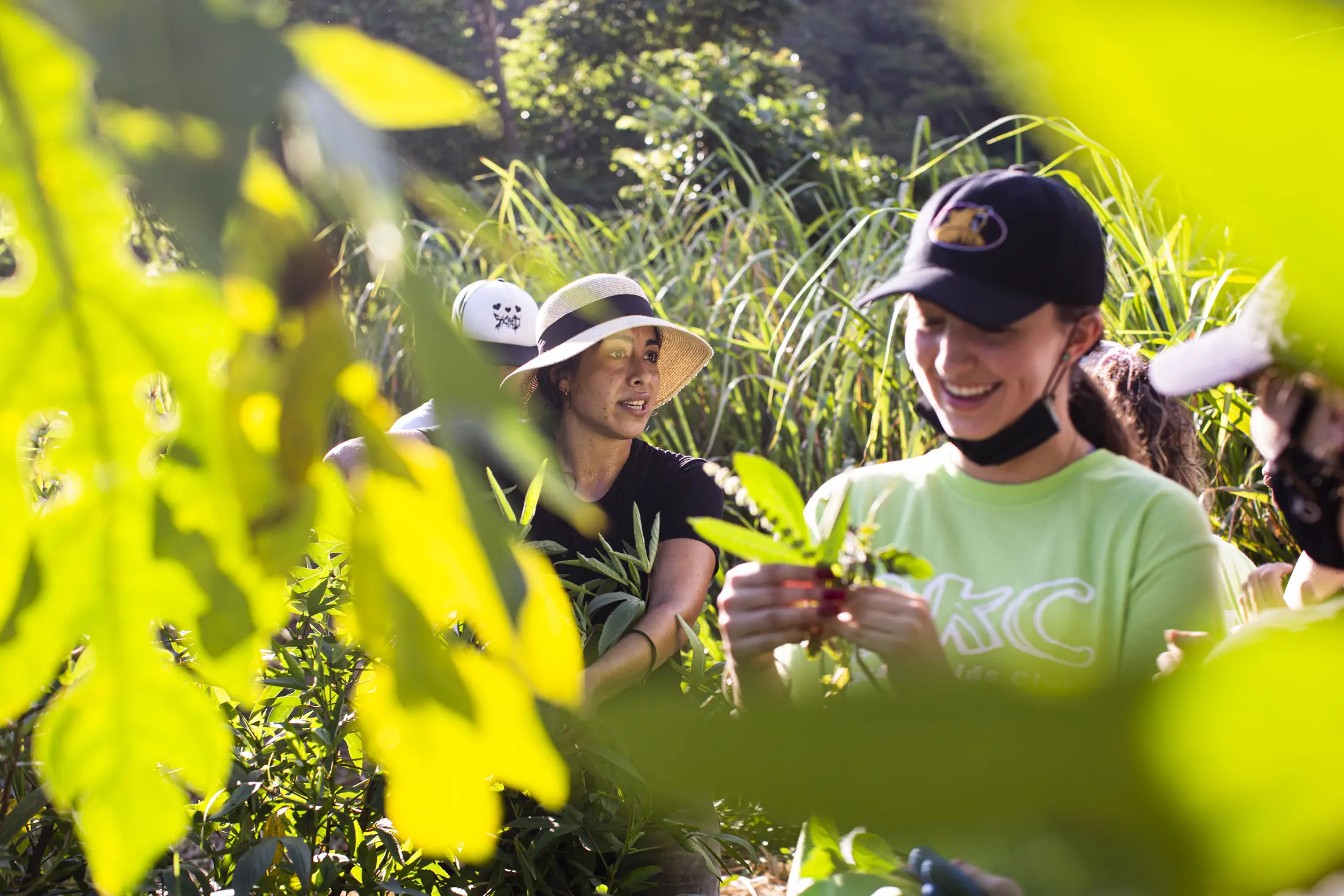
Hurricane María blew away Carmen Ana Acevedo’s farm, leaving only a single bunch of bananas among the collapsed fruit trees.
The mountains that surround Cacao, her valley community in the Puerto Rican mountain town of Orocovis, were a wind-burnt landscape of browned foliage. Acevedo’s neighbors — fellow farmers of plantains, bananas, and coffee — also lost their harvests.
The nearest town center was nearly an hour away. Overflowing rivers and creeks had caved bridges and flooded streets. The monstrous 2017 storm blew down power lines and polluted the water supply.
“It was like a nuclear bomb,” said 66-year-old Acevedo.
For three months after the storm, Acevedo and her neighbors, many elderly, relied on canned food reserves, donated hot meals, helicopter drop-offs, and the limited local supermarkets.
“We were disconnected from the world,” Acevedo said.
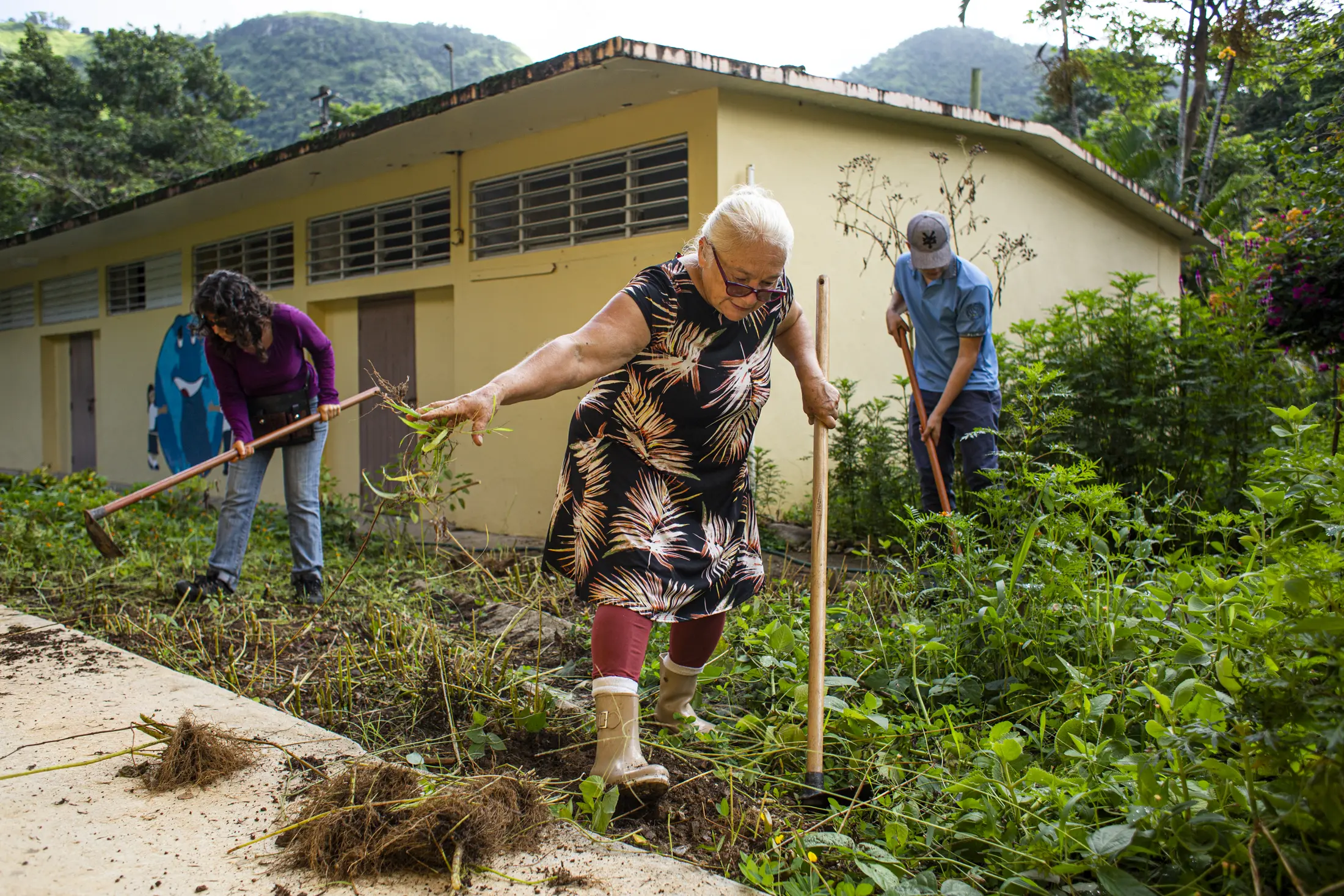
Some 15 miles away in Barrio Botijas, another community in Orocovis, the scene was remarkably different.
Right after the hurricane passed, a group of elementary school agriculture students cleared the way of trees and zinc roofs to their school farm. They surveyed the rain-soaked earth, cultivated the soil, and made compost out of Maria’s destruction.
Two months later, the students at Escuela Segunda Unidad Botijas #1 were producing enough food for about 200 people. The students took fresh cilantro and cabbage home. The beans became lunches for the rural community at the school cafeteria.
“They knew what to do in the middle of the storm. Literally,” said Dalma Cartagena, a 63-year-old teacher who ran the children’s agriculture program at Botijas for two decades.
The school farm became a principal supply of fresh food for the community for nearly six months, experts later found. It is one of at least 50 initiatives that self-identify as part of Puerto Rico’s agroecological movement, which uses available natural resources to boost crop and livestock production on an island that imports most of its food.
Agroecological farmers aim to work hand in hand with nature, reducing dependence on external materials, like purchased seeds, and shunning synthetic chemicals used in conventional farming. They plant fruits and vegetables together, instead of just one crop, and collect rainwater for irrigation. Growing nitrogen-rich beans and using organic compost become alternatives to fertilizer. Eggshells and neem oil, a naturally occurring pesticide, shoo away and kill crop-hungry bugs.
Hurricane Maria, which killed thousands of people, decimated eighty percent of Puerto Rico’s crop value — wiping out plantains, coffee, and banana farms. It closed down and complicated port operations, slowing down help and interrupting supply chains. Federal officials acknowledged the pace of relief could not overcome meal shortages reported the Guardian at the time.
But agroecological projects recuperated more quickly than conventional farms after the storm, according to farmers and scholars, and fed communities where help didn’t come for a long time.
Proponents say agroecological farms could produce as much as two-thirds of the food that Puerto Rico’s population of 3.2 million consumes, breaking the island’s long-standing reliance on importing between 80 and 90 percent of food and offering protection from food shortages after natural disasters.
“I do not lose hope that Puerto Rico will do that at the national level,” said Cartagena.
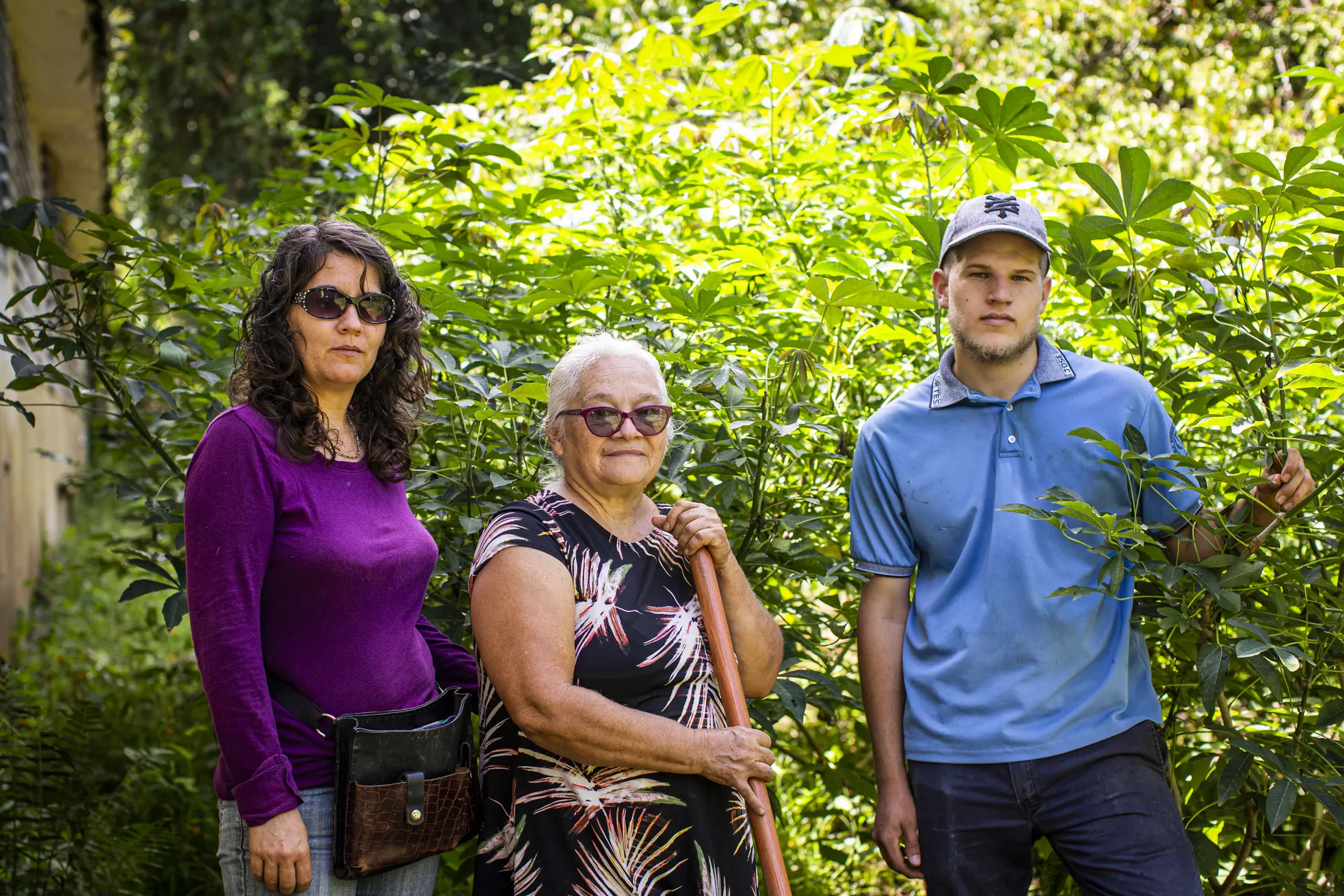
Legacy of Colonial History
Puerto Rico’s colonial history has meant the island traditionally grew cash crops like sugarcane and tobacco for export, instead of prioritizing local consumption, a legacy that influences the island’s modern agricultural systems.
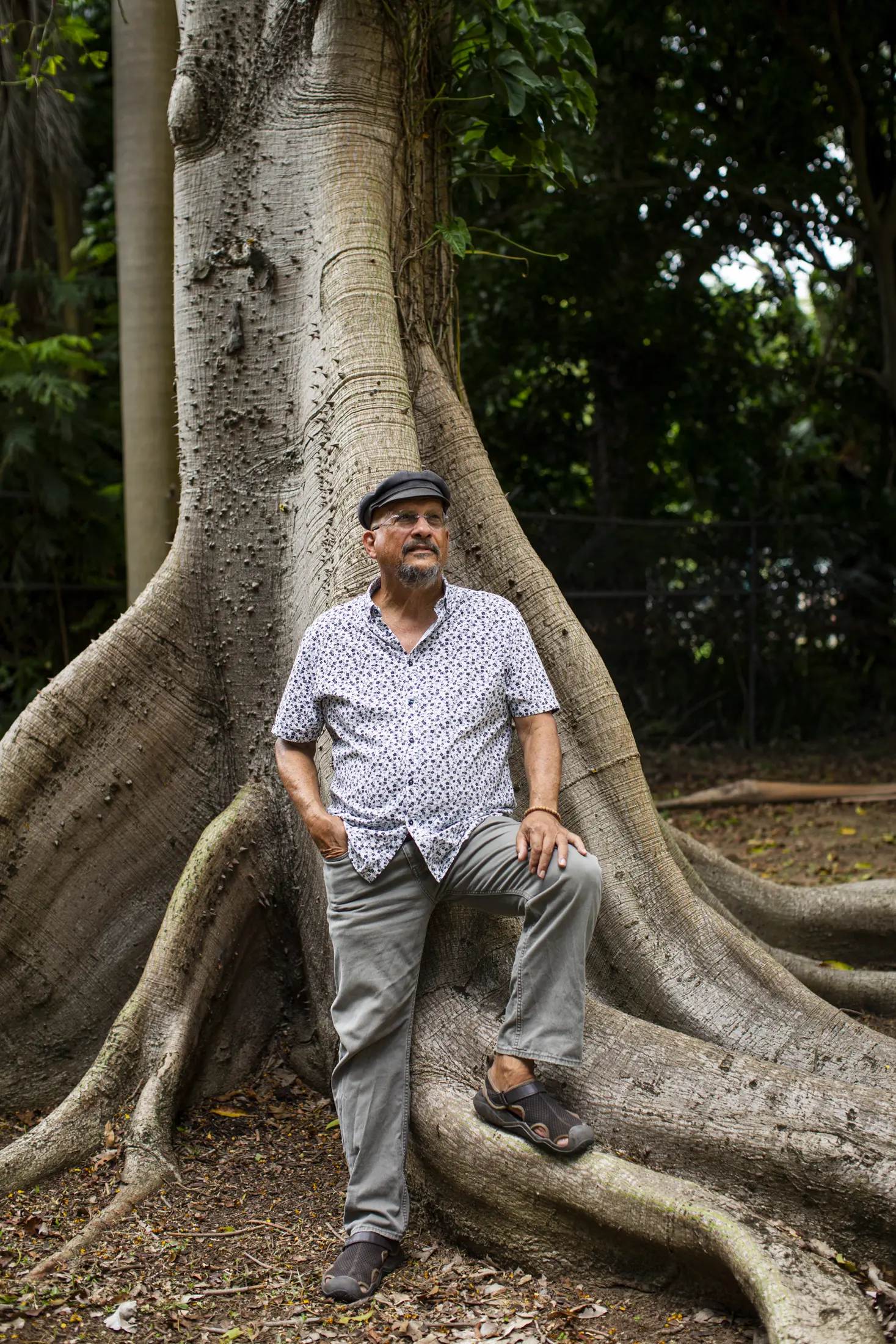
“What is not consumed is produced and what is not produced is consumed,” said Robinson Rodríguez Perez, a professor at the University of Puerto Rico.
When American governance began in 1898, an economic system called absenteeism replaced Spanish haciendas. American plantation owners might have never visited Puerto Rico, but they managed the production from a distance, Rodríguez Perez added. The 1899 San Ciriaco hurricane destroyed farmlands, leaving many Puerto Ricans hungry and poor.
Dalma Cartagena’s grandfather was born in 1898, the same year the United States invaded Puerto Rico during the Spanish-American war. He was an obrero agrícola, a tobacco farmer working for others, and married a craftswoman.
Though the island was planted full of sugarcane and other cash crops, residents like Cartagena’s grandfather produced 65 percent of all food consumed in 1939, according to historical records. The island began industrializing in the mid-20th century when the government lured American companies with manufacturing opportunities. As farmers lined up at factory assembly lines, Cartagena watched her grandfather cultivate his home’s lush land in Botijas, the same neighborhood where she would teach decades later.
“I had no things, not a single pair of shoes,” she said. “But I was raised on the abundance of food.”
The grounds, balcony, and kitchen of her grandparents’ home were filled with homegrown fruits, medicinal herbs, and vegetables, roots tangling into each other. They raised pigs, chickens, and cows and harvested milk and eggs.
Cartagena saw how multiple crops could grow together without the use of pesticides and chemical fertilizers. Her upbringing led her to train as an agronomist at the University of Puerto Rico. But the school was steeped in the Green Revolution — a post-World War II agriculture that increased production by emphasizing the use of chemicals, she said. Cartagena abandoned the university for six years, but eventually graduated and worked at the Department of Agriculture.
“I see the environmental disaster in the coffee plantations. So I started looking....There had to be other alternatives,” she said.
She convinced the public agency to let her enroll in a soil conservation class and eventually stumbled onto agroecology.
“All the activity in my grandparents’ home was around that way of life,” she said. “Agroecology is nothing new.”
After decades of the agricultural land shrinking year after year, by the late 2000s, the island was importing more than 80% of its food.
Other Puerto Ricans, many of them young, have joined Cartagena in recent years, creating agroecological farms with the hopes of creating an agricultural system that can feed the island.
Growing Food Year-Round
In the mountain town of Aibonito, the agroecological farm Armonía en la Montaña works to expand access and production of healthy foods. The location’s cool temperatures allow the farm to grow produce like cabbage against the backdrop of the Cordillera Central, the mountain range that cuts through the island from east to west. Fields of orange, yellow and purple flowers live among harvests to attract pollinating bees.
“The best food in Puerto Rico, the best pesticide-free food, grown with intention and love, is grown in the mountains and in disadvantaged rural areas of Puerto Rico,” said Daniella Rodríguez Besosa, the biologist-turned-farmer who co-founded Armonía en la Montaña along with her team. But poverty can make it harder for residents of these areas to afford healthy or agroecologically grown foods, she added.
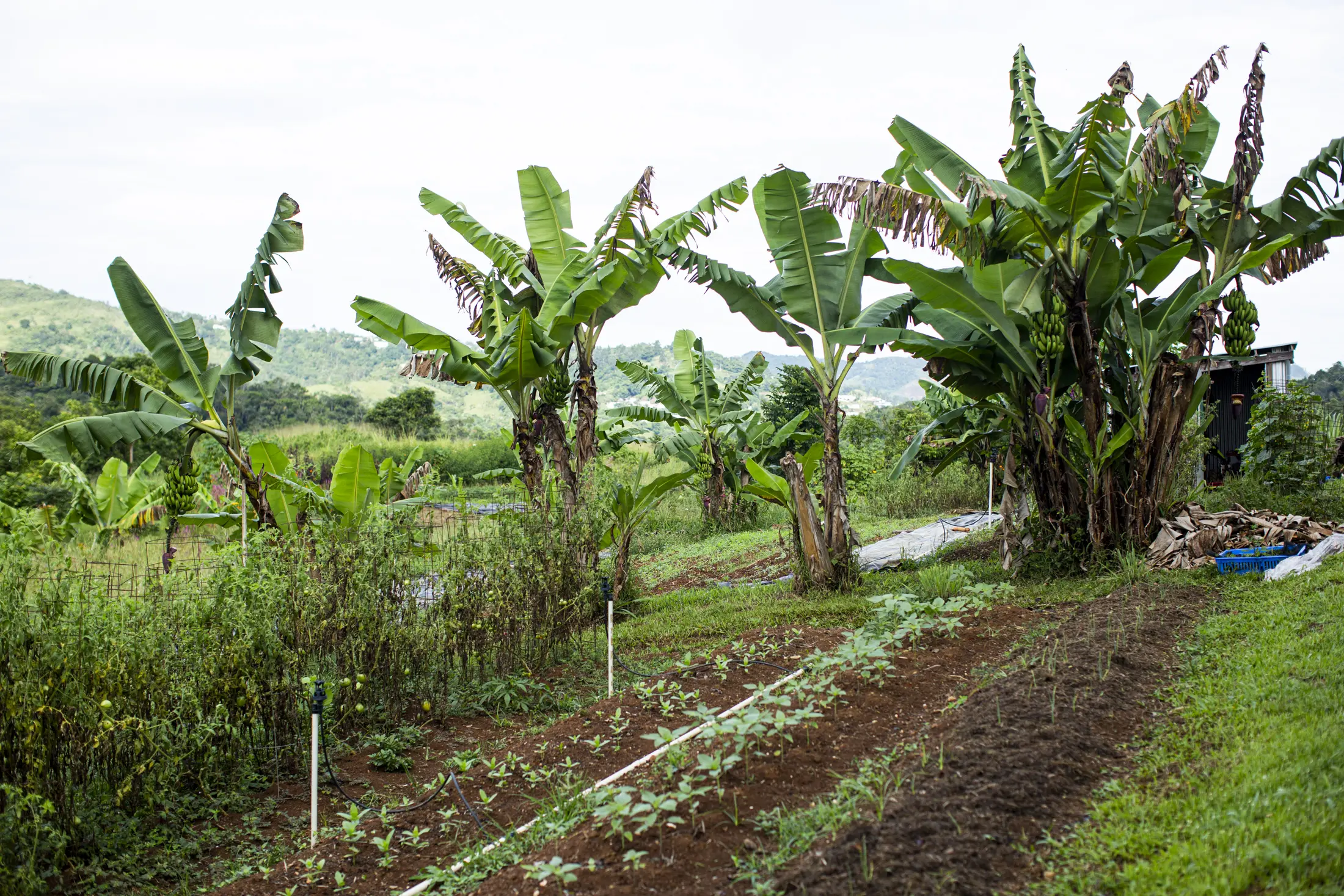
Research shows maritime shipping regulations, along with Puerto Rico’s island geography, make importing food costly — and more vulnerable, depending on supply chains severed by a shipwreck or a storm. Grocery store items in the San Juan area are nearly 21% more expensive than the U.S. national average; the island’s poverty rate is 43.5%, compared to the national average of 10.5%.
Increasing agroecology production could drive food costs down and make more food available, especially in low-income communities, Rodríguez Besosa and other farmers say. And it could offer a much-needed injection for the struggling local economy, adding as much as over one hundred thousand jobs, said social ecologist and agroecology expert Nelson Alvarez Febles.
“It’s an agriculture that requires thought and analysis, that requires that they be veterinarians, soil experts, that they know the weather like the traditional peasant,” he said.
Besides growing vegetables and fruits, Armonía en la Montaña runs a food hub that offers free food distribution services for local farmers and workshops to teach others agroecological farming. It’s all part of Rodríguez Besosa’s vision of a Puerto Rico where local agriculture can guarantee both food security — the availability of sufficient nutritious food for all residents — and food sovereignty: that local farmers and residents can control how it’s grown and distributed.
“This is definitely something that can change the world. You have all the potential to reverse so many problems, social, environmental, economic,” Rodríguez Besosa said. “There is so much intertwined and rooted in [agroecology.]”
Experts such as Alvarez Febles, along with farmer and scientist Georges Félix, say it’s possible. The island could yield about two-thirds of all the food it needs for all its residents if it redeveloped its 600,000 acres of reserved agricultural land for agroecological farms, the experts write in the book “Climate Justice and Community Renewal.”
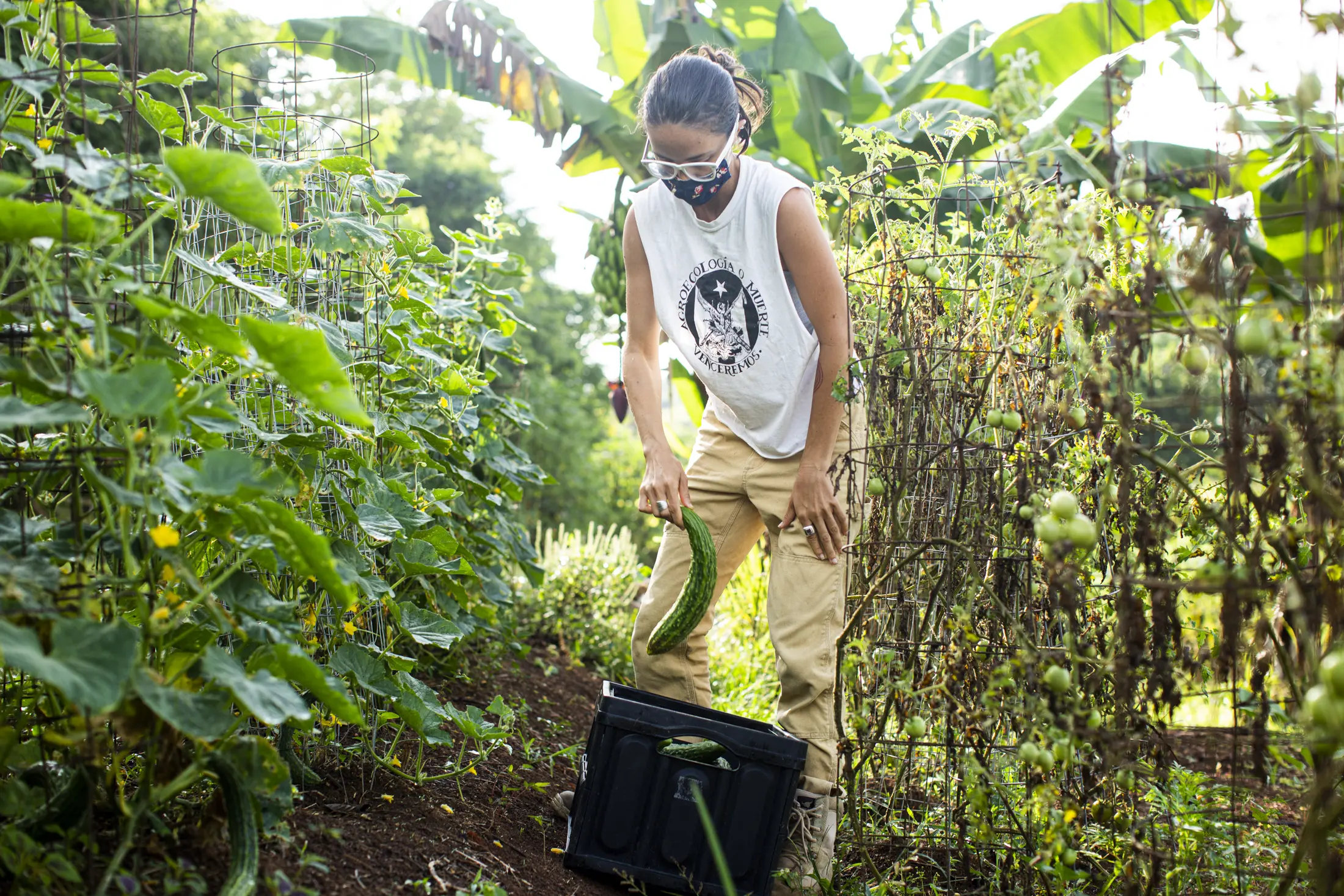
A higher local capacity for production through agroecology could safeguard Puerto Rico’s food supply year-round and in times of emergency, especially as climate change looms. The phenomenon is already causing higher temperatures in Puerto Rico, according to the Environmental Protection Agency, making an increase in hurricane wind speeds and rainfall rates more probable.
Storms with heavy rains like Hurricane María’s are five times more likely to hit the island today than in the mid-20th century, according to a University of Alabama and Sonoma State University investigation. And the 2017 storm demonstrated the island is only a disaster away from a food crisis.
“We found communities in places like [the town of] Añasco were so isolated that they didn’t even have water to drink or ways to communicate. They survived drinking coconut water,” and river water, said Robinson Rodríguez, the rural sociologist.
Devastation after storms like Maria is inevitable, but agroecological techniques can adapt better and increase resiliency after natural disasters compared to conventional farms, say experts and farmers.
“The agroecological farmer has been active all year round and when the emergency comes, is ready to provide assistance to the population,” said Rodriguez Pérez.
He found that the majority of agroecological producers were up and running less than a month after Hurricane Maria — a finding similar to one in a 2002 study that found Central America’s agroecological farms bounced back more quickly after Category 5 Hurricane Mitch in 1998.
“Many [agroecological farms] were able to save products, especially those grown underground,” said Rodríguez Pérez, “and in many places, they were the main source of food, while aid arrived and chains were reestablished.”
The Güakiá Agroecological Collective, an 11-acre farm in the northern town of Dorado, was shaped in large part in the aftermath of Hurricane Maria. The farm’s four young founders launched the project in an abandoned lot in San Carlos, a poor neighborhood without a sewage system, the summer before the storm. With donations from the community and other agroecological projects — Güakiá had not begun farming when Maria came — the farmers cooked 150 lunches every week in a satellite dish antenna the storm had blown off a roof.
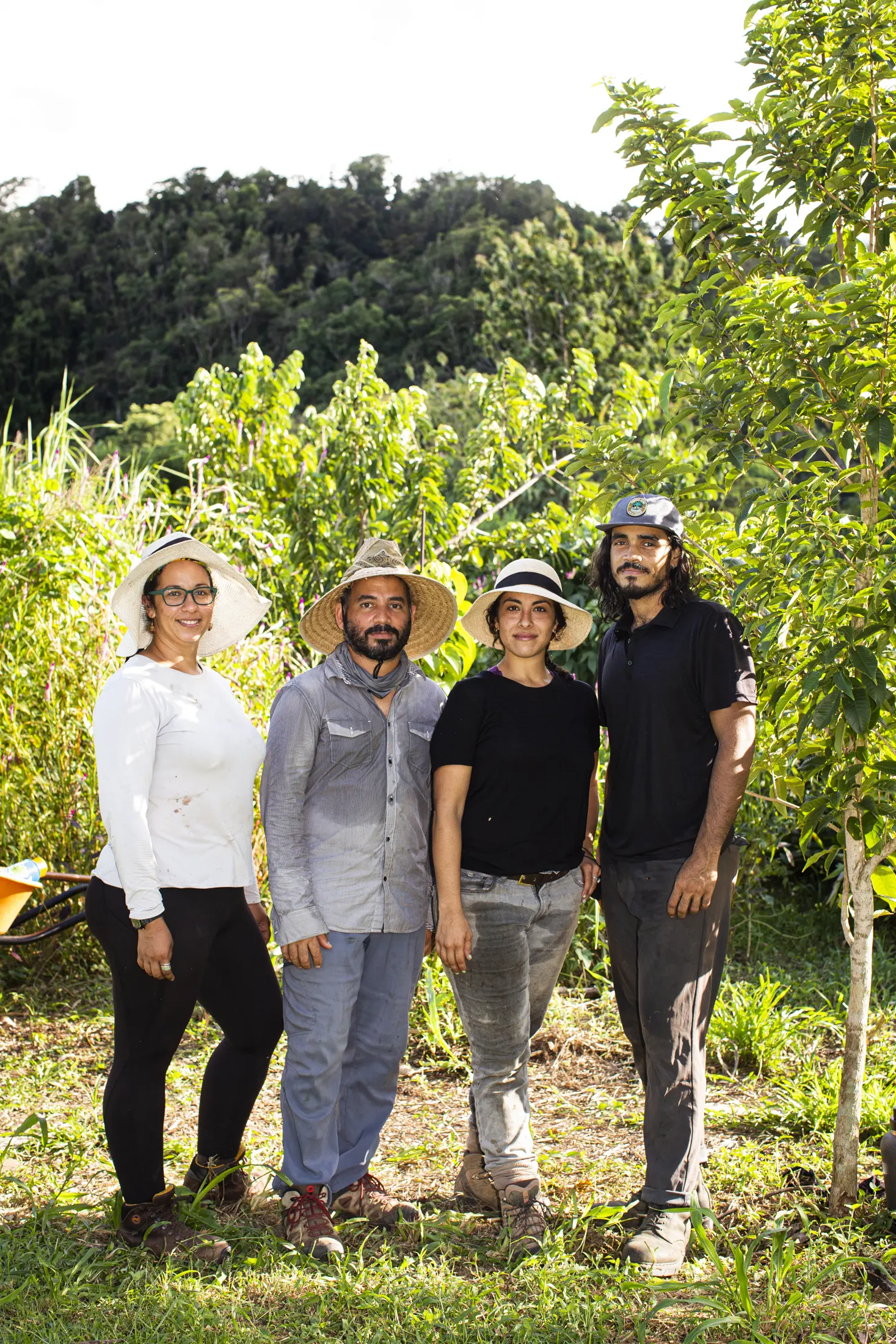
With no direct source of water, the Güakiá collects rain in huge white containers. Mogotes, the forested limestone hills, shield the farm from strong winds and rains. Yuca and batata, root vegetables that can survive hurricane winds, grow below the shade of guanabana trees, which also protect low-growing plants.
“One of the things that makes agroecological projects stronger is their ability to transform quickly,” said Marissa Reyes, a founder of the collective, “unlike a conventional space with one crop where you lose everything and you have to start from scratch.”
With no direct source of water, the Güakiá collects rain in huge white containers. Mogotes, the forested limestone hills, shield the farm from strong winds and rains. Yuca and batata, root vegetables that can survive hurricane winds, grow below the shade of guanabana trees, which also protect low-growing plants.
“One of the things that makes agroecological projects stronger is their ability to transform quickly,” said Marissa Reyes, a founder of the collective, “unlike a conventional space with one crop where you lose everything and you have to start from scratch.”
More Government Help Needed
But farmers and scholars say official institutions and public policies — insurance that doesn’t cover integrated multiple crops, an agricultural census that doesn’t fully capture agroecological production, and a lack of economic incentives — offer little support to agroecological projects.
“The official agricultural establishment in Puerto Rico has not been able to integrate the productive complexity of agroecology,” said Alvarez Febles.
Myrna Comas, a former agriculture secretary and a food security expert, promoted agroecological production through home, community and school gardens, emphasizing their key role in increasing access to healthy foods. But she also underscored the department’s dual mission of food security and economic development, telling the Miami Herald that to receive more government help, agroecological farms must generate profits and production.
“There are incentives [for] carrying out agroecological practices... but they have to be commercial farms. They cannot be agroecological projects of the home or community garden,” she recalled telling farmers during her administration.
Ramón González, a farmer who is the current secretary of agriculture, told the Herald he is working to establish more accessible incentives for small- and medium-scale farmers and prioritize the agricultural census. Farmers and scholars say that the government must provide more money and resources if they want agroecology to scale up and succeed.
“Agroecology not only produces the economic product but also produces social welfare, health, soil, habitat for biodiversity,” said Felix, the farmer, and scientist.
They dismiss critiques that agroecological farms in Puerto Rico are too small to feed many people. On about one-quarter of an acre of forest with over a dozen crops including fruit trees, Guakiá told the Herald, the collective has harvested 300 pounds of sweet potatoes and 150 pounds of pumpkins in the last nine months.
“The government does not help,” Félix said. “They do not see it as viable because it does not produce according to their standards.”
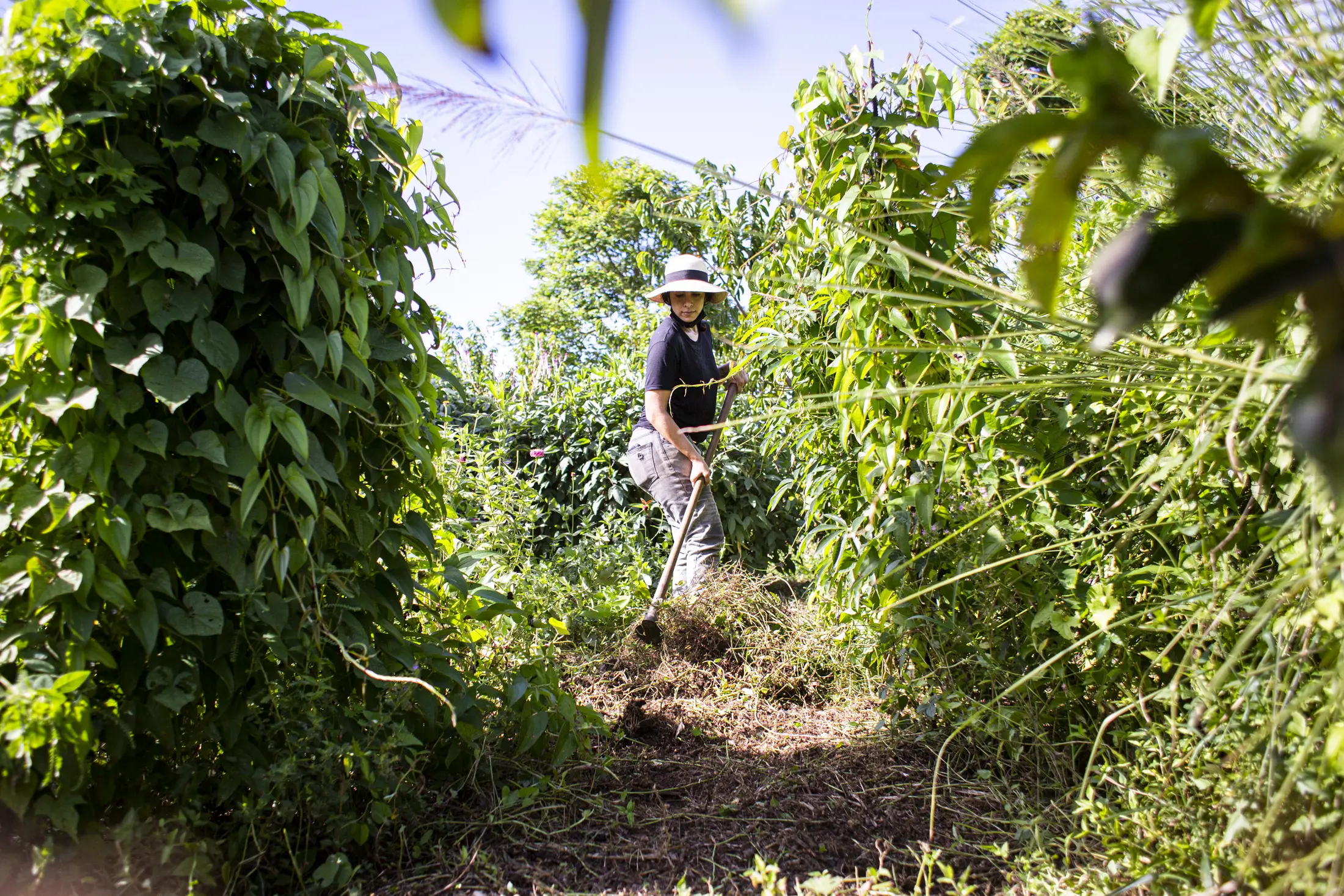
'A National Call for Food Production'
In Orocovis, Cartagena retired from public school teaching in 2020. Now, she runs the Escuelita de la tierra, the School of the Earth.
“Learning with the land is joy,” she said. “It’s about man leaning on nature and aligning himself with nature to produce food in abundance with things already given in nature.”
She dreams of creating a network of agroecological farms across Puerto Rico, but has started in her own community, helping launch three projects in other neighborhoods of Orocovis, including one at an elementary school.
“There must be a national call for food production,” she said. “All sectors, all communities, have to produce food and become aware of the importance of food production.”

Last year, along with other residents, Cartagena and Acevedo rescued Escuela Angel Gabriel Rivera, a school that shuttered before Maria. The mountains of dead plant matter at the abandoned grounds were used to fertilize their first salad greens, harvested within 45 days of opening the farm.
Today, the rocky school grounds, nestled in the verdant valley that houses Barrio Cacao, have since bloomed into soil banks that feature kale, eggplants, basil, and zucchinis. The old classrooms have been outfitted with seed storage and tools.
“The farm gives you security because you always find something,” said Acevedo,
who works at the school farm three times a week and manages volunteers.
Barrio Cacao was left scrambling for fresh food and water sources when Hurricane Maria struck. But Acevedo is confident that should a storm come, the school farm’s crops will feed neighbors in need.
“In this space, we can sow so everyone has food,” she said. “It belongs to the community.”









